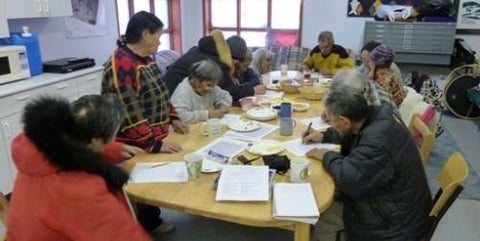
Throughout 2010, Bryan has worked on a research project about the Thelon River. The research involves working with wilderness tourists
(canoe travellers) and local Inuit (Qamani’tuaq residents) to document stories and experiences about the Thelon using photographs contributed by research participants. This information is then shared in community research workshops to cultivate understanding and enhanced social
and ecological responsibility concerning this special and changing place. The research is important because Inuit and non-Inuit (Qablunaat) participate in documenting different knowledge of, and values associated with, the Thelon, which is then shared between and within cultural groups. This participation and exchange of information is designed to enable inclusive and respectful understanding.
As of December 1, 2010 most of the research was complete. Bryan visited Qamani’tuaq three times: once in May for three weeks; once in July for one and a half weeks; and once again in November for two weeks. Throughout the year, Bryan also worked in Ottawa and Toronto to
meet with people who have canoed along Thelon River in different summer seasons. Table 1 summarizes the research fieldwork involving research participants.
| Project Component | Group/Type | Details |
|---|---|---|
| Photographic Interviews | People of Qamani’tuaq | Ten participants, 120 photographs contributed |
| Canoe tourists | Twenty seven participants, 340 photographs contributed | |
| Experiential River Trips | Snow machine | a) Qamani’tuaq to Halfway Hills b) Qamani’tuaq to cabin at Kangirjuaq |
| Honda (ATV) | a) Qamani’tuaq to Prince River b) Qamani’tuaq to cabin at Kangirjuaq |
|
| Motorboat | Qamani’tuaq to Kazan River | |
| Canoe | Thelon Wildlife Sanctuary | |
| Community Workshops | Outdoor educators from Ontario | Nineteen participants in 1.5 hour workshop |
| Arctic College Nunavut Teacher’s Education Program (NTEP) Students in Qamani’tuaq | Nine participants, 1.5 hour workshop | |
| Qamani’tuaq Elders | Ten participants, 2.5 hour workshop |
The project includes photographic interviews with ten Qamani’tuaq residents. These participants contributed to the project their own Thelon River photographs and used these to tell the stories that they felt important to share. Thirteen similar interviews were done with Thelon tourists, which were supplemented by another 14 Qablunaat participants that submitted photographs and knowledge through an email questionnaire. In total, more than 450 photographs from the Thelon River have been contributed.
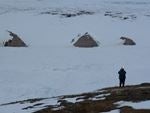
Near Halfway Hills, May 2010
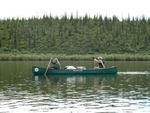
Canoeing along the Thelon River, July 2010

Canoeists near Beverly Lake, July 2010
Another part of the research involves experiential river trips, both with Inuit and Qablunaat users of the Thelon. During his three research visits to Qamani’tuaq, Bryan used notes, photographs, and a GPS to document five river trips. One trip was by motorboat, two were by snow machine, and two were by ATV (Honda). Each of these were a half or full day in length. In July, Bryan used the same methods of documentation on a professionally guided 10-day canoe journey with Qablunaat tourists, a trip that finished near Beverly Lake.
Community workshops are the third component of the project involving research participants. In September, Bryan met with a group of 19 outdoor educators who live and work in Ontario, but who are familiar with the Thelon River. Sixty-nine photographs contributed by interview and questionnaire participants, and identified either as “meaningful,” “significant,” or representative of “responsibility” were displayed. The contents of the photographs were discussed in smaller groups, and workshop participants were invited to identify the photographs that most closely reflected their ideas of “nature” and/or “responsibility.” Two similar workshops were held in Qamani’tuaq during Bryan’s November visit. The first was with nine members of the Nunavut Teacher’s Education Program at the Arctic College. The second was with ten Elders who have lifelong connections to the Thelon. The same 69 photographs were shared at each workshop, and resulted in the exchange of many different stories about the Thelon River.
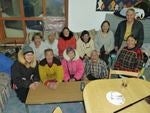
Following a Nov. 2010 workshop with Elders

NTEP student workshop, Nov. 2010
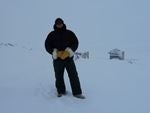
Bryan at a cabin near Kangijuaq, Nov. 2010
Over the next number of months, Bryan will be sorting through and organizing all the photographs and knowledge contributed to the project. Key contacts in Qamani’tuaq will be invited to assist with this research analysis. Copies of the research material will be delivered to the Arctic College and the Itsarnitaqarvik Inuit Heritage Centre during Bryan’s next visit to Qamani’tuaq, which is anticipated for the spring or fall of 2011. Bryan will also be using the project information to prepare a PhD dissertation, which he expects to submit next summer. A full copy of the dissertation will be available at the Heritage Centre in Qamani’tuaq, and a summary of research findings will be distributed to all individual participants, as well as supporting community organizations, including: the Hamlet of Baker Lake; the Qamani’tuaq Hunter’s and Trapper’s Association; the Nunavut Research Institute; and the Canadian Canoe Museum.
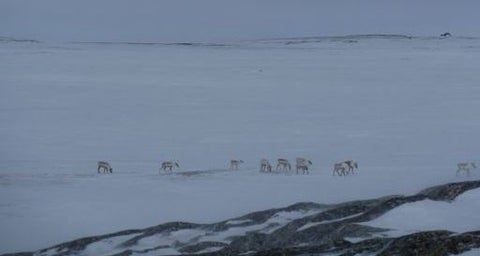
Caribou near Blueberry Hill, May 2010
Acknowledgements
Thank you to all of the Qamani’tuaq residents and Thelon River canoe travellers who have shared their knowledge, and to the community organizations that have supported the project. Special thanks to Anautalik and Alex Hall for their guidance and contributions. Carleton University, Social Sciences and Humanities Research Council of Canada, NSTP (INAC), and Tourism Cares provided research funding, and First Air and the Canadian Canoe Museum provided generous in-kind support.